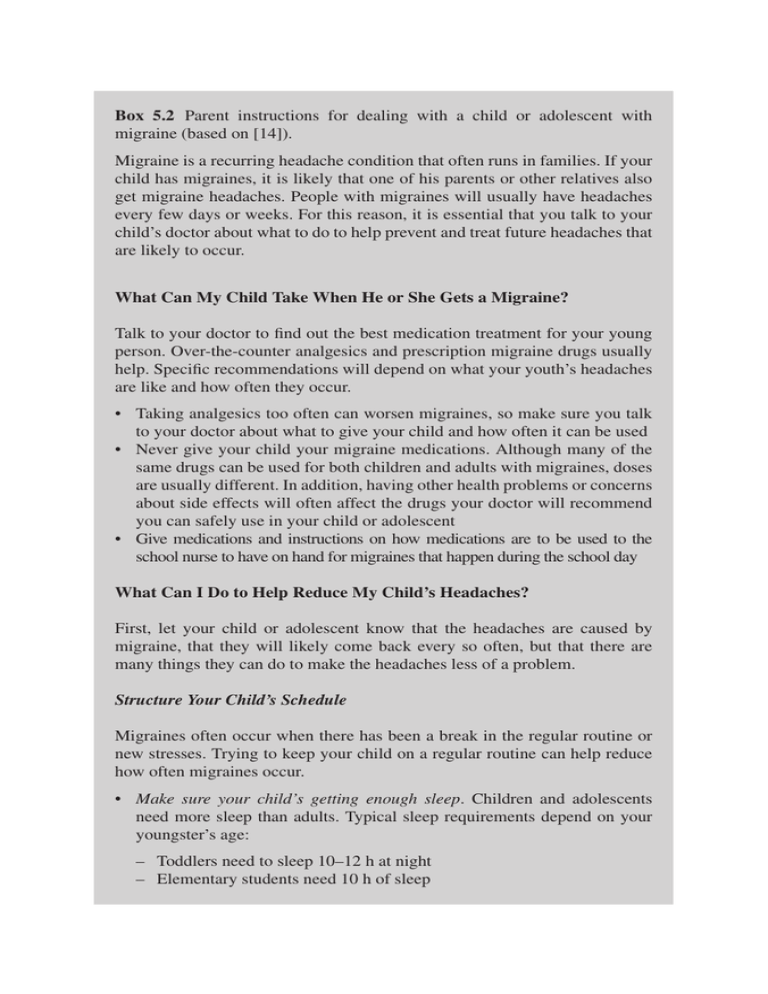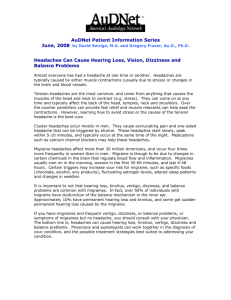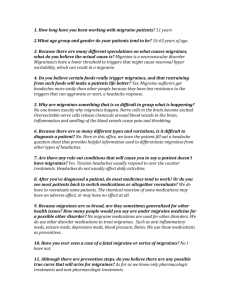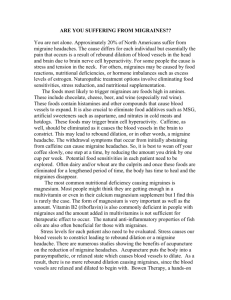Box 5.2
advertisement

Box 5.2 Parent instructions for dealing with a child or adolescent with migraine (based on [14]). Migraine is a recurring headache condition that often runs in families. If your child has migraines, it is likely that one of his parents or other relatives also get migraine headaches. People with migraines will usually have headaches every few days or weeks. For this reason, it is essential that you talk to your child’s doctor about what to do to help prevent and treat future headaches that are likely to occur. What Can My Child Take When He or She Gets a Migraine? Talk to your doctor to find out the best medication treatment for your young person. Over-the-counter analgesics and prescription migraine drugs usually help. Specific recommendations will depend on what your youth’s headaches are like and how often they occur. • Taking analgesics too often can worsen migraines, so make sure you talk to your doctor about what to give your child and how often it can be used • Never give your child your migraine medications. Although many of the same drugs can be used for both children and adults with migraines, doses are usually different. In addition, having other health problems or concerns about side effects will often affect the drugs your doctor will recommend you can safely use in your child or adolescent • Give medications and instructions on how medications are to be used to the school nurse to have on hand for migraines that happen during the school day What Can I Do to Help Reduce My Child’s Headaches? First, let your child or adolescent know that the headaches are caused by migraine, that they will likely come back every so often, but that there are many things they can do to make the headaches less of a problem. Structure Your Child’s Schedule Migraines often occur when there has been a break in the regular routine or new stresses. Trying to keep your child on a regular routine can help reduce how often migraines occur. • Make sure your child’s getting enough sleep. Children and adolescents need more sleep than adults. Typical sleep requirements depend on your youngster’s age: – Toddlers need to sleep 10–12 h at night – Elementary students need 10 h of sleep – Teenagers still need more than 9 h of sleep each night – If your child or adolescent cannot fit in all of his or her after-school activities, dinner, homework, and adequate sleep time, reduce the amount of after-school commitments • Keep a regular bedtime. Bedtime needs to be no later than 10 p.m. If your child or adolescent is unable to sleep, she can be allowed to listen to the radio or read a book. She should not be watching television, texting, talking on the telephone, or snacking after bedtime • Set a regular time to get up. This time needs to allow adequate time for getting ready for school. Regular bed and rise times need to be maintained even for kids who are already out of school on homebound education • Maintain regular meal times. Your adolescent must eat breakfast, lunch, and dinner everyday. Skipping meals is a common headache trigger • Maintain a regular homework. Schedule a regular homework time and location that’s not in front of the television or computer games • Maintain enjoyable leisure activities. These activities will preferably take your child out of the house and encourage socialization. Limit time playing computer games or surfing the Internet. Limit time spent watching television or movies. Encourage activities like walking, shopping, sports, and socializing Identify Stress Factors in Your Youngster’s Life Stress is the most common migraine trigger for both children and adults. There are many circumstances that increase stress for children and adolescents. These may include • • • • • • • • • School course work Difficulty interacting with a peer group or bullying Excessive after school commitments Depression Anxiety Fears of health conditions or illness Family strife Sexual issues Drug exposure or pressure These should be addressed by your child’s doctor, psychologist, or counselor. What About School? Research shows that most youngsters have their migraines on school days during regular school hours. This does not mean they are faking the headaches to get out of school. School can be very stressful for young people – for academic, athletic, and social reasons. Missing school, however, adds extra stress that can further aggravate headaches. Good school participation, including regular attendance, must be a top priority. In most cases, your child should attend school – even when she has a migraine. • Migraines usually go away after 1 or 2 h, so your child shouldn’t need to miss a day of school for a migraine • Going to school usually won’t make a headache any worse. In fact, being at school can help distract your child from headache symptoms • If your child gets frequent headaches, he should probably only miss school time when vomiting and should attend school later that day once the headache symptoms lessen Talk to your youngster’s teacher and nurse to let them know that your young person has migraines and what has been recommended for treatment. If headaches occur during the school day, the child should be allowed to leave the classroom to go to the nurse. The nurse may administer prescribed medication and allow the child to use pain management techniques, like relaxation techniques. Unless the child is vomiting, he or she should return to the classroom after 15–20 min. School is important for social, emotional, and intellectual development. If a child or adolescent has been unable to attend school, work with your youngster’s healthcare provider, school nurses, guidance counselors, and teachers to help make a successful return to school and then to maintain attendance. A return to school can begin with attending low-stress classes and lunch period.



